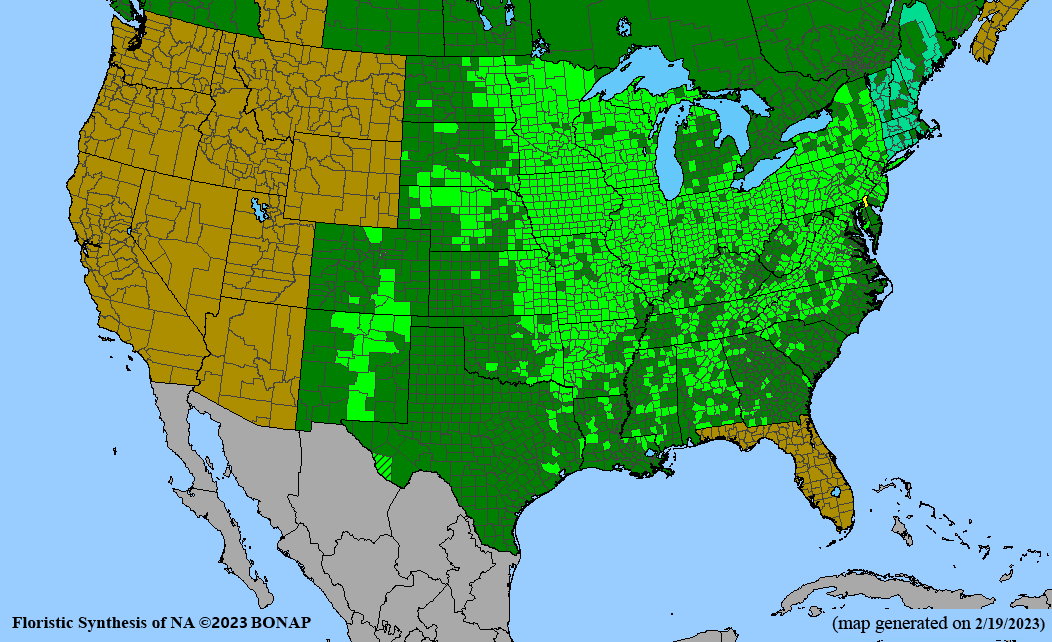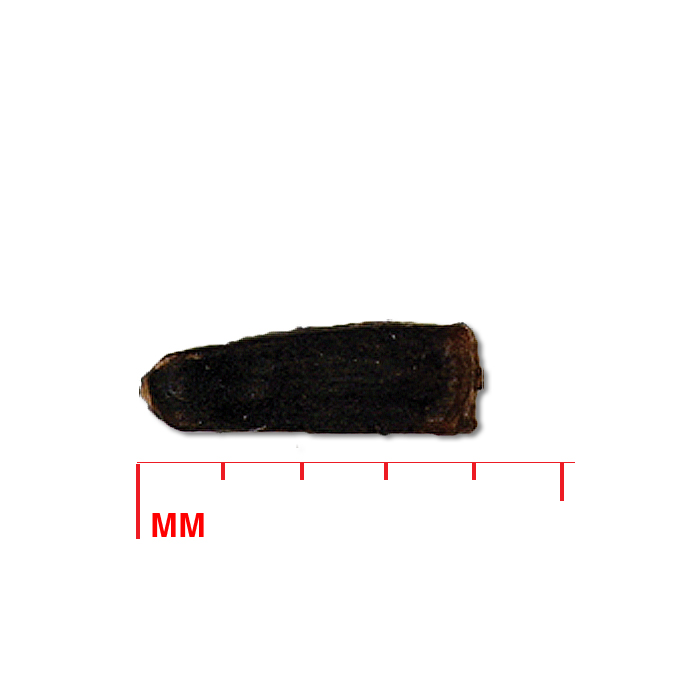smooth oxeye
smooth oxeye sagem
Heliopsis helianthoides (L.) Sweet
Alternate Common Names: common ox-eye, false sunflower, sunflower heliopsis, ox-eye, sunflower-everlasting
Scientific Synonym: Buphthalmum helianthoides L.
Family: aster family (Asteraceae)
Functional Group: forbs (wildflowers)
Description
- Life cycle and growth form
Perennial, fibrous rooted, producing clumps or colonies from rhizomes.
Height: 2-6 ft
- Leaves and stem

Leaves opposite, egg-shaped with pointed tips, saw-tooth margins, rough texture, up to 5 in long and 3.5 in wide; stem is erect, rough with short hairs, branched.
- Flower, fruit and seedhead
Flower: One to 15 sunflower-like yellow flower heads, 1.5-3 in (4-7.5 cm) in diameter, at ends of long stalks from stem tip and upper leaf axils; ray florets are yellow-orange color, center disk usually golden yellow; underside of the flower head with alternating short and long bracts (phyllaries).
Fruit/seedhead: Flower head matures to a head of “seed” (achenes); achenes are dark, 3-4 angled, 4-5 mm long, and lack pappus; both disk and ray florets are fertile and produce achenes.
Pollination: Insects such as bees, wasps, beetles, flies, and butterflies.
- Seed
Seed characteristics
Seeds per ounce: 6,300 (IA NRCS)
Seeds per pound: 100,800 (IA NRCS)
1000 seed weight: 4.15 g (Seed Information Database)
Description: Seed unit is a smooth, dark achene about 3/16 in (4-5 mm) long.
Typical seed test
PLS: 95% (n = 10)
Purity: 100% (n = 10)
Germination: 65% (n = 9)
Dormant: 31% (n = 9)
(averages obtained from n tests of purchased seed lots)
- Habitat and range
Habitat: Dry-mesic to wet-mesic soil; full sun; low to high quality remnant prairies, disturbed areas, roadsides, railroads, woodland openings and edges, thickets, streambanks, limestone glades. Wetland Indicator Status is Facultative Upland (FACU) for the Midwest.
Conservation status: Global- G5, secure; Delaware- S1, critically imperiled; Louisiana- S3, vulnerable (NatureServe)

General Comments
Smooth oxeye is a component of most tallgrass prairies with medium to dry soils where it grows in association with tall, warm-season grasses. The long flowering time and abundant nectar and pollen make this an important pollinator resource, and the nutritious seeds are eaten by birds and mammals. This species is fairly easy to establish by direct seeding, if good seedbed preparation and weed suppression are achieved. Extended flowering and seed-ripening period makes determining optimal combine harvesting time difficult. Seed cleaning is accomplished with air-screen cleaning.
Recommendations for Seed Production
- Establishment for seed production
Direct seeding
Row spacing: 30-36 in rows
PLS pounds/acre: 4.0
Seeds per linear foot: 40
Seeding depth: 1/4 in
Seeding method: native seed drill
Seeding time: dormant season
Weed control: Prepare clean, firm, weed free seedbed prior to seeding.
Greenhouse
Seed pre-treatment: Wet stratify 8-12 weeks at 40° F.
Sowing: Sow seed at 1/4 in depth about two months before the last frost-free date.
Transplanting: Harden off, transplant into bare soil in rows or weed barrier at 8 in intervals after all danger of frost. Since this species spreads by rhizomes to form clumps, remove weed barrier after establishment year or use biodegradable barrier.
- Stand management
Weeds: Mow/cultivate between rows. Post emergence grass herbicide, tillage, roguing.
Pests: Plants may be affected by red aphids (Uroleucon) though these infestations are often cleared by parasitic wasps and aphid predators, and it is not clear that they cause much harm to the plants.
Diseases: Powdery mildew.
- Seed production

First harvest: Some flowering and seed production in first growing season from transplants and in well-managed direct seeded stands.
Yield: 20-115 pounds/acre (per acre yield extrapolated based on production from 1 plot)
Stand life: Peak harvest second-fourth year with declining yields in subsequent years.
Flowering date: early June - late July in northern Iowa
Seed maturity/Harvest date: mid-August to late September in northern Iowa; complicated by long flowering and seed ripening period.
Seed retention: Shattering occurs mid to late October.
Harvest date range at TPC (2005-2008): Sept 15 - 21
Recommended harvest method: Combine
- Seed cleaning and storage
Cleaning process: Pre-clean by scalping through 1/2 in and 1/4 in mesh to remove large plant matter and make flowable, then air-screen. (No awns or appendages to remove.)
Seed storage: cool/dry (33-50° F, 30-50% RH)
Released Germplasm
Source Identified material: Central Iowa Germplasm (IA Zone 2), Northern Iowa Germplasm (IA Zone 1), Southern Iowa Germplasm (IA Zone 3)
Cultivated variety (cultivar): Midas (KS)
- References
Chayka, K. (n.d.). Heliopsis helianthoides (smooth oxeye). Minnesota Wildflowers. https://minnesotawildflowers.info/flower/smooth-oxeye
Cochrane, T. S., Elliot, K., & Lipke, C. S. (2014). Ox-eye. In Prairie plants of the University of Wisconsin-Madison Arboretum (3rd ed., p. 88). University of Wisconsin-Madison Arboretum.
Hilty, J. (2019). False sunflower - Heliopsis helianthoides. Illinois Wildflowers. https://www.illinoiswildflowers.info/prairie/plantx/fs_sunflowerx.htm
Houseal, G. A. (2007). Forbs wildflowers. In G. A. Houseal (Eds.), Tallgrass Prairie Center’s native seed production manual (pp. 36–37). Tallgrass Prairie Center - University of Northern Iowa.
Kartesz, J.T., The Biota of North America Program (BONAP). 2023. North American Plant Atlas. (http://bonap.net/napa). Chapel Hill, N.C. [maps generated from Kartesz, J.T. 2023. Floristic Synthesis of North America, Version 1.0. Biota of North America Program (BONAP). (in press)]
NatureServe. 2024. NatureServe Network Biodiversity Location Data accessed through NatureServe Explorer [web application]. NatureServe, Arlington, Virginia. Available https://explorer.natureserve.org/. (Accessed: February 29, 2024).
Runkel, S. T., & Roosa, D. M. (2009). Ox-eye. In Wildflowers of the tallgrass prairie: The upper Midwest (2nd ed., pp. 162–163). University of Iowa Press.
Smith, A. R. (2020, November 6). Heliopsis helianthoides (Linnaeus) Sweet. Flora of North America. http://floranorthamerica.org/Heliopsis_helianthoides
USDA NRCS National Plant Data Team. (n.d.). Heliopsis helianthoides (L.) Sweet. USDA plants database. https://plants.usda.gov/home/plantProfile?symbol=HEHE5
Species Guide Updated 12/11/2024
